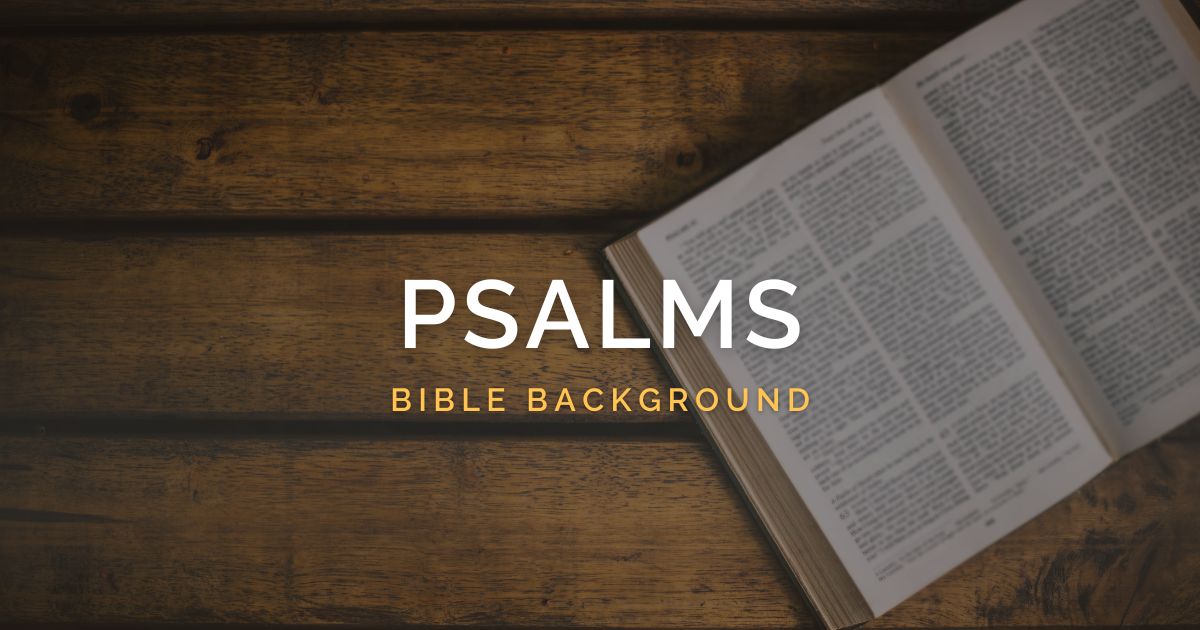Who
David, Solomon, Asaph, Sons of Korah, Moses, Heman, Ethan, Nehemiah (?), Samuel (?), Hezekiah (?), and a handful of Unknown Authors to God (on behalf of Israel all throughout her history from wilderness wanderings to post-exile in Babylon)
Where & When
The Psalms are a compilation of 150 (or perhaps 143 or so, depending on whether some psalms were originally written together as one; e.g., Psalms 9–10; Psalms 42–43; etc.) lyrical songs of praise, thanks, lament, confession, instruction, wisdom, and imprecation to Yahweh the God of Israel. Each psalm was composed to be used in corporate daily life of Israelite worship, often with musical accompaniment. The composition of the psalms spans the history of Israel’s existence as a nation, from the psalms of Moses in the wilderness (Psalm 90 and perhaps Psalm 91) all the way through the exile to Babylon and the unimpressive return of the remnant to the Holy Land and the rebuilding the walls and the temple by 450 BC. Likely, most psalms were penned in Jerusalem by David (perhaps up to 91 psalms), but other locations might include Babylon (in exile), Shiloh, and Ramah. The historical setting of each psalm varies from psalm to psalm, but all psalms carry a unified theme of praise to Yahweh with a special focus on the Kingdom of God that will one day rule the nations under the dominion of the Messiah, the true King of Israel.
Why
To praise Yahweh as the true King of Israel who will usher in His Kingdom through His Servant David—a future Messiah that all the nations will worship.
How
Be paying attention to these important terms that occur in this book:
- Praise
- Kingdom (or King)
- Fear of the Lord (or Fear of Yahweh)
- Salvation
- Selah (stylistic musical term-- perhaps a climactic moment in music to pause for contemplation)
It is also instructive to note that Habakkuk 3:19 exemplifies that the musical notation (e.g., “for the choir director” and the instruments to be used) may belong at the end of the previous psalm, not at the beginning of each psalm. For example, the musical notation on Psalm 4, “For the choir director, on stringed instruments” may be better assigned to Psalm 3 than Psalm 4. This theory of psalm-title organization is not definitively provable, but it is likely. However, it does not affect any parts of the titles relating to authorship or setting. Authorship and setting notes would still belong at the beginning of each psalm under this theory.
Literary Outline
The psalms were composed by a variety of authors over several hundred years of Israel’s history. In this way, each psalm acts as its own independent unit. However, there is a strong argument to suggest that the psalms were intentionally compiled during the post-exilic period before the completion of Scripture to reflect a thematic order. This order is reflected in the outline below. The subjects and terminology used in each of the psalms in these sections strikingly mirror the subjects and terminology in each of the respective books of Moses. Each section ends with a refrain of praise (Ps. 41:13; Ps. 72:19–20; Ps. 89:52; Ps. 106:48; Ps. 150:6b), which provides an objective, grammatical signal for each section's discrete corpus.
- Psalms 1 – 41 Book 1: Genesis, defining the King (WHO)
- Psalms 42 – 72 Book 2: Exodus, defining the Kingdom (WHAT)
- Psalms 73 – 89 Book 3: Leviticus, the King’s Purity (HOW)
- Psalms 90 – 106 Book 4: Numbers, the Exile of the Kingdom (WHEN)
- Psalms 107 – 150 Book 5: Deuteronomy, the Return of the Kingdom (WHY)
